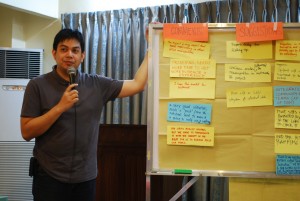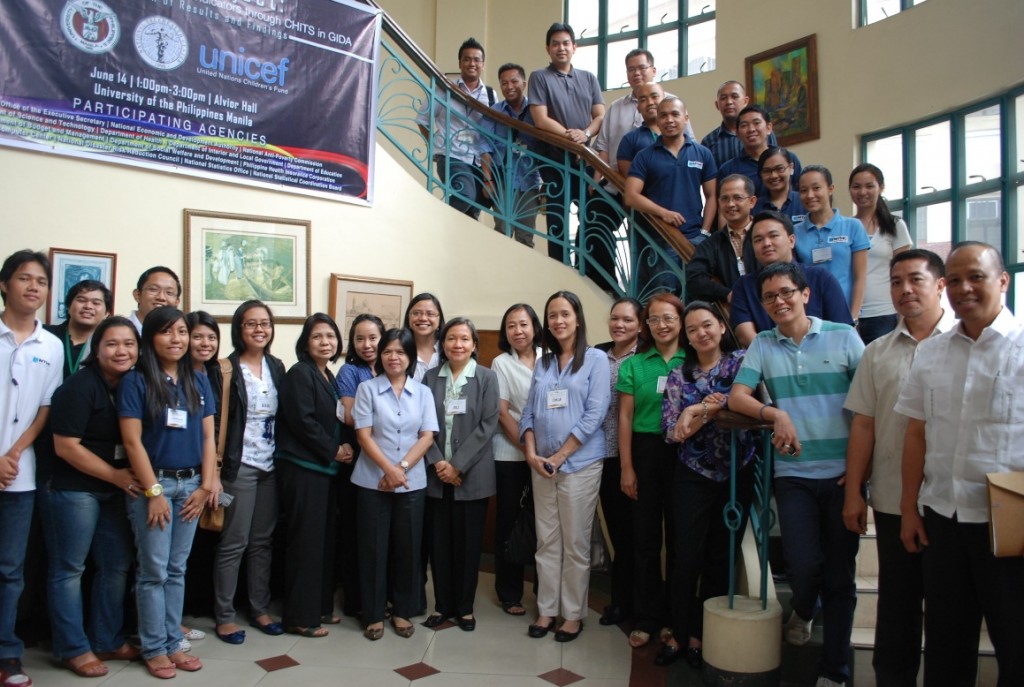NGAs Support rCHITS Expansion for Government Interoperability
June 25, 2012 4:24 pm | by Aliyah Lou Evangelista | Posted in News
Manila, Philippines-Undersecretaries and representatives from the education, health, social development, disaster, and governance sector convened at the University of the Philippines (UP) Manila and pledged support for the expansion of the an electronic medical record and a mobile reporting system which has the potential for integrating data from various government information systems.

JP Acuna, DSWD IT Team Leader, presenting his team's comments for rCHITS expansion. Acuna recommends rCHITS for implementing the Social Protection Support Initiative (SPSI).
rCHITS Expansion
“Real – Time Monitoring of Key Maternal and Child Health Indicators through the use of the Community Health Information Tracking System (CHITS)” or rCHITS is a project headed by the National Telehealth Center (NTHC). It was a five month project funded by the United Nations Children’s Fund (UNICEF).
General Leo Kison, consultantfrom the Office of the Executive Secretary under the Office of the President, reported that he has submitted an endorsement to Executive Secretary Paquito Ochoa to hasten government interoperability through rCHITS project.
“We can even campaign for the Department of Social Welfare and Development to use rCHITS for SPSI (Social Protection Support Initiative)” said JP Acuna, DSWD Information Technology Team Leader.
SPSI is a joint program of the Philippine Health Insurance Corporation (PHIC), DSWD, and the Department of Health (DOH) that establishes a medical referral system between government hospitals.
Time is of the Essence
rCHITS sprung from the need to monitor Maternal and Child Health (MCH) indicators on a real-time basis. Most government agencies uses MCH indicators in designing programs for women and children. However, since MCH reports are paper-based, MCH statistics are often delayed.
Dr. Geohari Hamoy, rCHITS Project Manager, said MCH indicators often take time to be reported to various levels of government since reports are submitted in paper form. As a result, health programs of the government are delayed.
In Gamay, Northern Samar, one of the threerCHITS pilot project sites, the rural health nurse needs to travel for about an hour or two on the unpaved roads of Mapanas, ride a boat for around 30-45 minutes to Laoang, plus an hour of land travel just to submit paper reports of their health center to Catarman, the provincial capitol.
Over time, the system evolved into collecting governance indicators on education, social welfare and development and disaster, as well.
Hamoy says that thismobile reporting systemcan be a tool for interoperability of government databases to reduce redundant collection and reporting of data.
Juli Ana Sudario, Deputy Managing Director of Department of Science and Technology-National Computer Center (DOST-NCC), expressed that rCHITS will help the government’s journey towards getting real time data from the ground.
Representatives from the Department of Health, Social Welfare and Development, National Economic Development Authority, Tarlac-Wireless Access for Health, National Computer Center, Office of the President, Office of the Executive Secretary, and the NTHC rCHITS Team.

Representatives from the Department of Health, Social Welfare and Development, National Economic Development Authority, Tarlac-Wireless Access for Health, National Computer Center, Office of the President, Office of the Executive Secretary, and the NTHC rCHITS Team.
Interoperability for Data Integrity
In a meeting with national agencies, February of this year, Richard Moya, undersecretary of the Department of Budget and Management, revealed that every agency has its own numbers to declare for similar set of indicators they collect.
Their reportsinclude varying figures that reflect status of MCH indicators collected for each agency’s project planning.
If pushedthrough, rCHITS project can facilitate efficient data exchange among government information systems. Each set of health data, whatever form they are collected, can be read and counted without duplication. This will improve reliability and integrity of the data that health workers report.
“rCHITS really works but we have to harmonize it with the concept of the PGIF (Philippine Government Interoperability Framework) for us to fully achieve our goals,” Acuna said when government agencies commented on the system.
DOST-NCC developed PGIF, a model that will allow information exchange across various databases. Data on a specific indicator collected by each agency will be reconciled with each other, thereby removing errors and duplication.
How does rCHITS work?
The project has three components: the Community Health Information Tracking System (CHITS), a java enabled-phone, and a web-based LGU Dashboard.
For example,when a pregnant woman visits the health center, her data is stored in a computer through CHITS. When she misses her appointment to the doctor, midwives do a follow-up check-up on her. Since midwives can’t bring CHITS during field visits, health data is stored in mobile phones. Data from the phones are then automatically synchronized in the LGU Dashboard for data visualization.
In a real-time manner, the dashboard provides local chief executives with organized information in maps, charts and graphs. This helps mayors to decide priority programs for their project planning, most especially during times of disasters.
A total of 77 health workers were trained on using rCHITS. Another set of 76 LGU personnel also underwent training on sending mReports.The mReports include governance indicators such as death, birth, immunization, delivery, maternal registration, patient, disaster, and early childhood care and development (ECCD) being transmitted to the LGU dashboard.
117M Mobile Phone Subscribers
By end of 2016, Business Monitor International, a country risk and industry company, reported that mobile phone subscribers in the country will shoot to 117M, a figure that will exceed more than Philippines’ current population.
Mobile phones are potential tools for electronically reporting governance indicators since they are portable, accessible, and widely used by health workers.
Dr. Hamoy reported that a total of 3,306 mReports have been recorded from April to May 2012, a proof that health workers can easily adapt to this change of reporting mechanism.
Pey Canlas of Tarlac Wireless Access for Health (WAH), said that “more information on LGU utilization of collected data” is needed to ensure sustenance of rCHITS next phase.
With rCHITS expansion, national agencies hope that the almost-a-decade-battle for government interoperability would eventually be a reality.